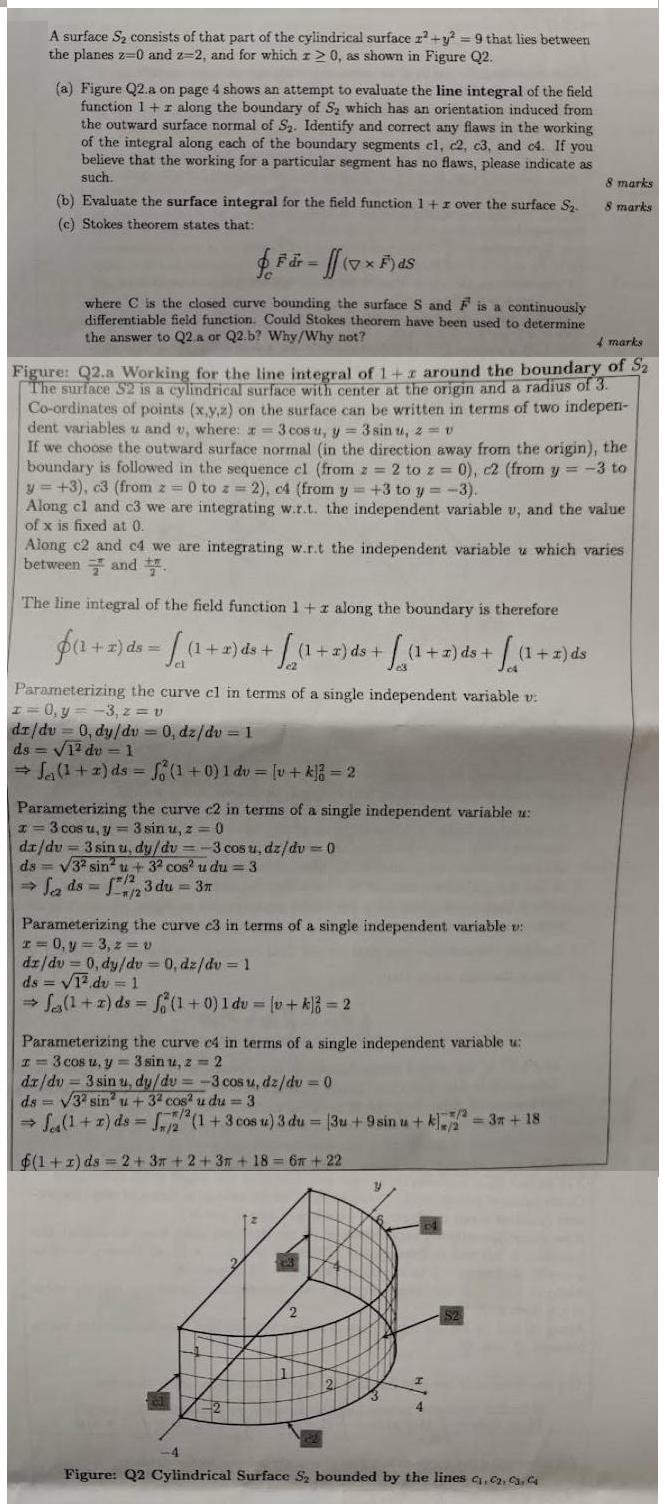Answered step by step
Verified Expert Solution
Question
1 Approved Answer
A surface S2 consists of that part of the cylindrical surface z+y? = 9 that lies between the planes z=0 and z=2, and for

A surface S2 consists of that part of the cylindrical surface z+y? = 9 that lies between the planes z=0 and z=2, and for which z> 0, as shown in Figure Q2. (a) Figure Q2.a on page 4 shows an attempt to evaluate the line integral of the field function 1+r along the boundary of S which has an orientation induced from the outward surface normal of S2. Identify and correct any fiaws in the working of the integral along each of the boundary segments cl, c2, c3, and c4. If you believe that the working for a particular segment has no flaws, please indicate as such. 8 marks (b) Evaluate the surface integral for the field function 1 +r over the surface S 8 marks (c) Stokes theorem states that: (0x F)ds where C is the closed curve bounding the surface S and F is a continuously differentiable field function. Could Stokes theorem have been used to determine the answer to Q2.a or Q2.b? Why/Why not? 4 marks Figure: Q2.a Working for the line integral of 1+z around the boundary of S2 The surface S2 is a cylindrical surface with center at the origin and a radius of 3. Co-ordinates of points (x.y.z) on the surface can be written in terms of two indepen- dent variables u and v, where: = 3 cos u, y 3 sin u, 2 = v If we choose the outward surface normal (in the direction away from the origin), the boundary is followed in the sequence cl (from z = 2 to z = 0), c2 (from y = -3 to y = +3), c3 (from z = 0 to z 2), c4 (from y = +3 to y = -3). Along cl and c3 we are integrating w.r.t. the independent variable v, and the value of x is fixed at 0. Along c2 and c4 we are integrating w.r.t the independent variable u which varies between and . The line integral of the field function 1+z along the boundary is therefore fa+2) ds = [(a+2)ds + (1+x) ds + (1+1) ds + (1+1) ds Parameterizing the curve cl in terms of a single independent variable v: I=0, y=-3, z = v dr/du = 0, dy/dv = 0, dz/dv = 1 ds = V1? dv = 1 = L(1+2) ds = (1 +0) 1 dv = [v+ k] =2 Parameterizing the curve c2 in terms of a single independent variable u: I = 3 cas u, y = 3 sin u, z = 0 dr/du = 3 sin u, dy/du = -3 cos u, dz/du = 0 ds = V3? sin u+ 32 cos? u du = 3 L, ds = S 3 du = 3n Parameterizing the curve c3 in terms of a single independent variable v: I= 0, y = 3, z = v dr/dv 0, dy/dv = 0, dz/dv = 1 ds = V1 du = 1 = fa(1+z) ds = (1+0)1 du =[v+ k]% = 2 Parameterizing the curve c4 in terms of a single independent variable u: I = 3 cos u, y = 3 sin u, z = 2 dr/dv = 3 sin u, dy/du = -3 cos u, dz/du = 0 ds = V3 sin u+ 32 cos? u du = 3 + L.(1+ r) ds = (1+3 cos u) 3 du = [3u + 9sin u + k = 3m + 18 1), $(1+1) ds = 2+37 +2+3T + 18 = 6m + 22 -4 Figure: Q2 Cylindrical Surface S2 bounded by the lines c, C2, Ca,
Step by Step Solution
★★★★★
3.35 Rating (173 Votes )
There are 3 Steps involved in it
Step: 1
2 Curves Given C l2 C3 C4 line inte goal along C C line y3 foom z2 ...
Get Instant Access to Expert-Tailored Solutions
See step-by-step solutions with expert insights and AI powered tools for academic success
Step: 2

Step: 3

Ace Your Homework with AI
Get the answers you need in no time with our AI-driven, step-by-step assistance
Get Started


